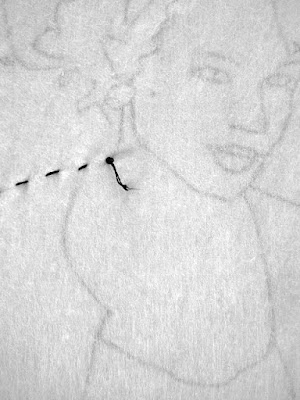What distinguishes a Glossy from other types of
embroidered work is the use of The Glossy Back Stitch.
Unlike traditional embroidery, your image is
transfered on the back-side of the fabric
and then the Glossy Back Stitch is worked on it.
transfered on the back-side of the fabric
and then the Glossy Back Stitch is worked on it.
The Glossy Back stitch is similar to
the traditional back stitch.
the traditional back stitch.
The difference is that you can change the length of each
stitch as you embroider your image.
Doing so results in a jagged and impressionistic design
on the right-side of the fabric.
Place the tracing on your fabric.
Then use a bone folder or a spoon to burnish the
pencil marks onto the back of your fabric.
pencil marks onto the back of your fabric.
When you are done, it will look something like this.
Then iron an iron-on interfacing or
stabilizer over the design.
This will prevent the pencil markings from rubbing off as
stabilizer over the design.
This will prevent the pencil markings from rubbing off as
you work and it will also make
the fabric a little heavier and stronger.
the fabric a little heavier and stronger.
Now start to embroider it.
Here is a link to:
When the entire piece is embroidered,
it will look something like this.
All the knots and loose threads will be visible
on the side you've stitched on.
Turn it to the right-side and it looks like this.
At this point, you can leave it as is, or
if you want to paint it, lightly gesso your Glossy.
Now you are ready to paint, applique, sew,
bead, cut in to, quilt, collage, watercolor,
gold leaf or embellish it any way you want.
When you are done, frame it or
wrap it over a canvas.
enjoy!
Alma Stoller







3 comments:
that is a very cool technique!
Lovely tutorial! Waht type of fusible interfacing do you use? Can you still see the pencil marks through it?
Alma - This is so awesome! Thanks for sharing this with us!
Post a Comment